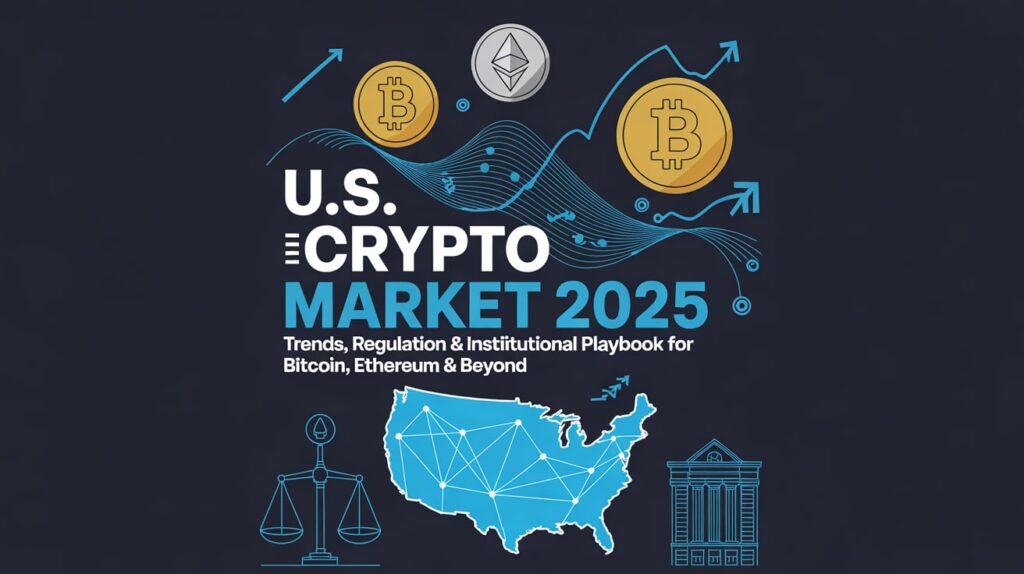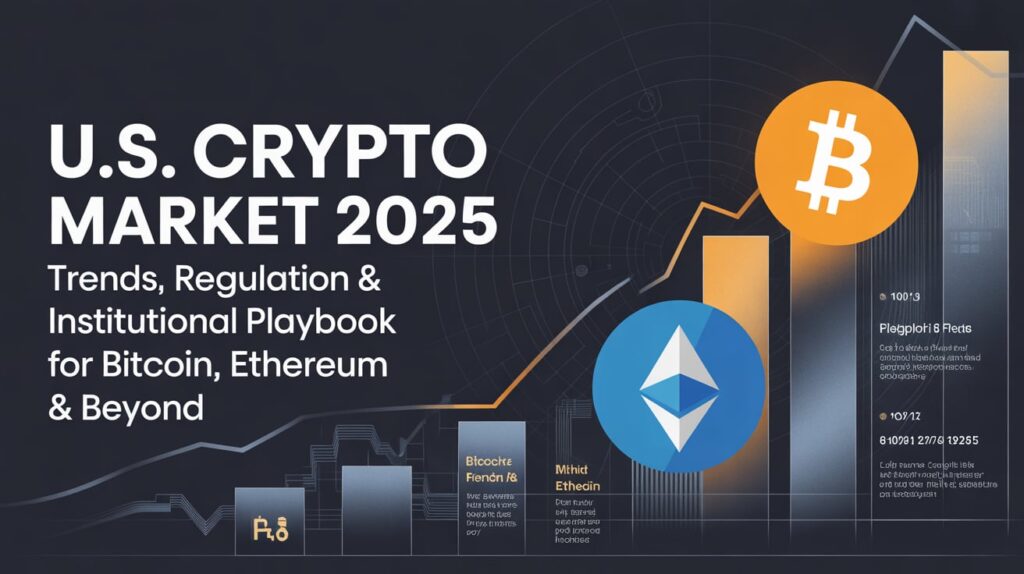U.S. Crypto Market 2025: Trends, Regulation & Institutional Playbook for Bitcoin, Ethereum & Beyond
The year 2025 marks a defining moment in digital finance as the U.S. Crypto Market 2025 takes center stage in global innovation, regulation, and institutional adoption. The American crypto ecosystem, once viewed as experimental, has now evolved into one of the most influential financial sectors driving blockchain’s real-world utility.
At BTCMARKETNEWS, we explore how the U.S. regulatory landscape, institutional strategies, and evolving investor sentiment are reshaping the digital asset market — from Bitcoin and Ethereum to the emerging frontiers of tokenization, stablecoins, and DeFi integration.
The Evolution of the U.S. Crypto Market
The past decade has seen the United States move from cautious observation to active participation in the blockchain revolution. Once defined by volatility and regulatory confusion, the U.S. Crypto Market 2025 is now characterized by structure, institutional maturity, and mainstream engagement.
According to industry research shared with BTCMARKETNEWS, over $3.5 trillion in total digital assets are now held or managed within the U.S. market — a record high, driven largely by Bitcoin ETFs, Ethereum staking platforms, and tokenized securities.
This transformation is not accidental. It reflects years of development in compliance frameworks, custody solutions, and market infrastructure, which have made crypto both accessible and credible for investors ranging from retail users to Wall Street giants.
Top Trends Defining the U.S. Crypto Market 2025
1. Institutional Dominance & the Rise of Crypto ETFs
The approval of spot Bitcoin ETFs in early 2024 set the stage for an institutional influx. By 2025, major asset managers like BlackRock, Fidelity, and Vanguard have diversified portfolios to include Bitcoin and Ethereum ETFs, sparking unprecedented liquidity in digital markets.
BTCMARKETNEWS reports that institutional participation now accounts for over 70% of all crypto trading volume in the U.S., signaling a new era where digital assets are treated as core components of modern investment strategies.
2. Ethereum’s Expansion into Real-World Assets
Ethereum continues to lead innovation through tokenization and DeFi infrastructure. In the U.S. Crypto Market 2025, Ethereum’s ecosystem underpins everything from real estate tokenization to government bond digitization.
Projects like JPMorgan’s Onyx and Franklin Templeton’s tokenized funds illustrate how blockchain is redefining asset management. These use cases highlight that Ethereum’s utility now extends beyond crypto — it’s the backbone of digital finance itself.
3. Stablecoins as the New Digital Dollar
Stablecoins such as USDC and PYUSD (PayPal USD) are emerging as key players in domestic and international transactions. They are being integrated into payment systems, remittance platforms, and corporate treasuries.
The U.S. Crypto Market 2025 reflects a broader trend toward programmable money, where stablecoins bridge traditional banking and decentralized finance. Their growth also lays the foundation for the potential introduction of a U.S. digital dollar (CBDC) in the coming years.
4. Regulation: From Uncertainty to Clarity
One of the biggest challenges in crypto’s early years was unclear regulation. In 2025, that narrative has changed dramatically. The U.S. government, through the Digital Asset Market Structure Act (DAMS) and SEC–CFTC coordination frameworks, has introduced clear compliance standards for exchanges, stablecoin issuers, and custodians.
BTCMARKETNEWS analysts note that this clarity has encouraged institutional adoption, reduced fraud, and built investor confidence — making the U.S. a global benchmark for responsible crypto innovation.
5. Tokenization & the Future of Wall Street
Traditional finance is going digital. Tokenized Treasury bonds, money market funds, and equities are now traded on blockchain rails. In the U.S. Crypto Market 2025, tokenization is redefining liquidity by enabling 24/7 settlement and fractional ownership.
Goldman Sachs, Citigroup, and other major institutions are launching on-chain asset services, combining blockchain efficiency with regulatory oversight. This fusion of Wall Street and Web3 is transforming how capital moves across global markets.
The Regulatory Landscape: SEC, CFTC & Beyond
While innovation thrives, regulation remains central to sustainable growth. The U.S. Crypto Market 2025 operates under a structured legal framework balancing innovation with investor protection.
-
The SEC oversees crypto securities and disclosure compliance.
-
The CFTC manages derivatives and commodities like Bitcoin futures.
-
The Treasury Department enforces AML and KYC standards for crypto institutions.
This coordinated approach marks the first time regulators and innovators are aligned toward a shared vision — building a transparent, compliant, and globally competitive crypto economy.
Institutional Strategies: Building the Playbook for Digital Assets
Institutions are no longer experimenting; they are executing full-scale crypto strategies. Here’s how the largest players are shaping the U.S. Crypto Market 2025:
-
Diversified Digital Portfolios – Asset managers allocate 5–10% of funds into Bitcoin, Ethereum, and select altcoins.
-
On-Chain Settlements – Banks use blockchain for instant clearing, reducing transaction costs.
-
Staking & Yield Strategies – Institutional investors earn passive income through Ethereum and Solana staking pools.
-
Custody & Compliance Solutions – Secure storage via regulated custodians like Coinbase Custody and Anchorage Digital.
-
DeFi Integration – Controlled exposure to decentralized protocols through institutional-grade liquidity pools.
As BTCMARKETNEWS reports, these strategies underscore the transition from speculative investing to structured, data-driven asset management.
The Role of Innovation: AI, Web3 & Smart Contracts
Artificial Intelligence (AI) and Web3 are converging with blockchain to redefine digital finance. AI-driven analytics platforms forecast market trends, while smart contracts automate everything from loan approvals to dividend payments.
In the U.S. Crypto Market 2025, this synergy creates intelligent, autonomous financial systems that reduce inefficiencies, eliminate fraud, and accelerate growth across sectors like insurance, supply chain, and global remittances.
Challenges Ahead: Security, Compliance & Market Volatility
Despite progress, challenges remain. Cybersecurity risks, smart contract vulnerabilities, and geopolitical tensions continue to test market resilience.
BTCMARKETNEWS analysts emphasize the need for robust on-chain risk monitoring, better education, and ongoing collaboration between public and private sectors. The path forward for the U.S. Crypto Market 2025 lies in balancing innovation with protection.
The Global Impact: America Leads the Blockchain Race
The United States’ leadership in crypto policy, infrastructure, and innovation has positioned it as a global hub for blockchain development.
From Silicon Valley startups to Wall Street giants, the U.S. Crypto Market 2025 is setting the pace for global adoption — proving that blockchain is not a passing trend but the future fabric of financial systems worldwide.
Conclusion
The U.S. Crypto Market 2025 represents a mature, regulated, and innovation-driven ecosystem where digital assets and traditional finance converge. Institutional adoption, regulatory clarity, and technological advancement are fueling a new era of digital capitalism.
As BTCMARKETNEWS continues to track these developments, one fact is undeniable — America’s crypto transformation is shaping not just its financial future, but the trajectory of the global economy itself.
FAQs – U.S. Crypto Market 2025
1. What defines the U.S. Crypto Market 2025?
It refers to the evolving U.S. digital asset ecosystem, marked by regulatory clarity, institutional adoption, and integration with traditional finance.
2. Are crypto ETFs legal in the U.S. now?
Yes, Bitcoin and Ethereum ETFs have been approved, enabling institutional and retail investors to gain regulated crypto exposure.
3. How are U.S. regulators treating DeFi projects?
DeFi platforms are now required to follow disclosure and KYC standards under the updated Digital Asset Market Structure Act.
4. What role do stablecoins play in 2025?
Stablecoins act as digital dollars powering payments, remittances, and decentralized finance ecosystems across the U.S.
5. How can investors stay informed about the U.S. Crypto Market 2025?
Follow reliable platforms like BTCMARKETNEWS for verified updates, market analyses, and institutional trend reports.



